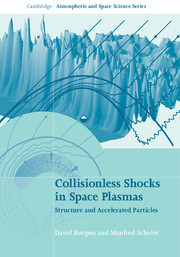Book contents
- Frontmatter
- Contents
- Preface
- Chapter 1 Shocks
- Chapter 2 Basic concepts
- Chapter 3 The quasi-perpendicular shock: macrostructure
- Chapter 4 The quasi-perpendicular shock: microstructure
- Chapter 5 The quasi-parallel shock
- Chapter 6 Diffusive shock acceleration
- Chapter 7 Coherent shock acceleration
- Chapter 8 Electron acceleration
- Chapter 9 Global and modified shocks
- Appendix Simulation techniques
- References
- Further reading
- Index
Chapter 6 - Diffusive shock acceleration
Published online by Cambridge University Press: 05 August 2015
- Frontmatter
- Contents
- Preface
- Chapter 1 Shocks
- Chapter 2 Basic concepts
- Chapter 3 The quasi-perpendicular shock: macrostructure
- Chapter 4 The quasi-perpendicular shock: microstructure
- Chapter 5 The quasi-parallel shock
- Chapter 6 Diffusive shock acceleration
- Chapter 7 Coherent shock acceleration
- Chapter 8 Electron acceleration
- Chapter 9 Global and modified shocks
- Appendix Simulation techniques
- References
- Further reading
- Index
Summary
Observations of diffuse ions at heliospheric shocks
Virtually all shocks observed either in situ or indirectly in the solar system are accompanied by energetic particles, i.e., protons, heavy ions and electrons, with energies up to 1000MeV and higher. The most intense solar energetic particle (SEP) events are produced by acceleration at interplanetary shock waves driven by coronal mass ejections (CMEs). The intensity–time profiles of electrons and protons in CME as sociated particle events have usually a fast rise and a decay phase extending over several days. The shock passage at 1 au occurs early in the decay phase and is often accompanied by a peak in the lower-energy ions (˜1MeV). Since these events are long-lasting (several days) they have been termed gradual events, as opposed to impulsive events of a duration of approximately a few hours. The latter are associated with impulsive X-ray flares and type III radio bursts. X-ray emission from flares indicates plasma heating to temperatures of order ten million kelvin, and solar type III radio bursts imply the impulsive production of electrons travelling at 0.1–0.25 times the speed of light. Acceleration at the CME driven shocks populate magnetic field lines over a broad range of longitudes, while the impulsive event sare generally detected when the observer is magnetically connected to the flare site. Figure 6.1a shows the intensity–time profiles of particle fluxes (one electron and three proton energy channels) in a ‘pure’ gradual event accompanied by a CME and Fig. 6.1b shows an impulsive event due to a series of flares (Reames, 1999).
There is clear evidence that energetic ions are accelerated at interplanetary shocks out of the solar wind thermal population. Gosling et al. (1981) have transformed the ion distribution function measured over a wide energy range (10 eV to 1.6MeV) behind an interplanetary shock into the solar wind frame. Figure 6.2 shows a cut of the distribution function along the Sun–Earth line which demonstrates that the suprathermal distribution emerges smoothly out of the solar wind thermal distribution, which can be taken as evidence that the solar wind ions are accelerated to high energies.
- Type
- Chapter
- Information
- Collisionless Shocks in Space PlasmasStructure and Accelerated Particles, pp. 205 - 253Publisher: Cambridge University PressPrint publication year: 2015

